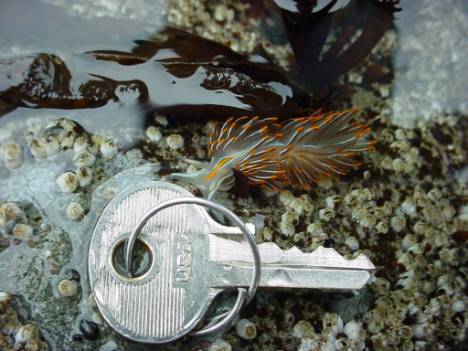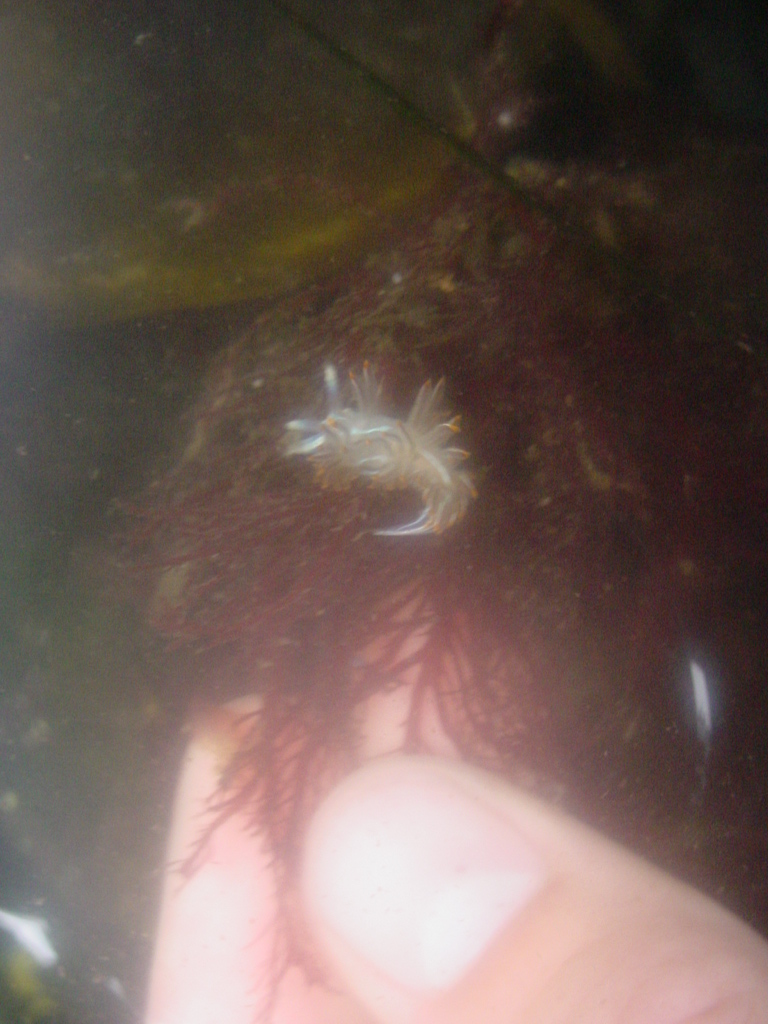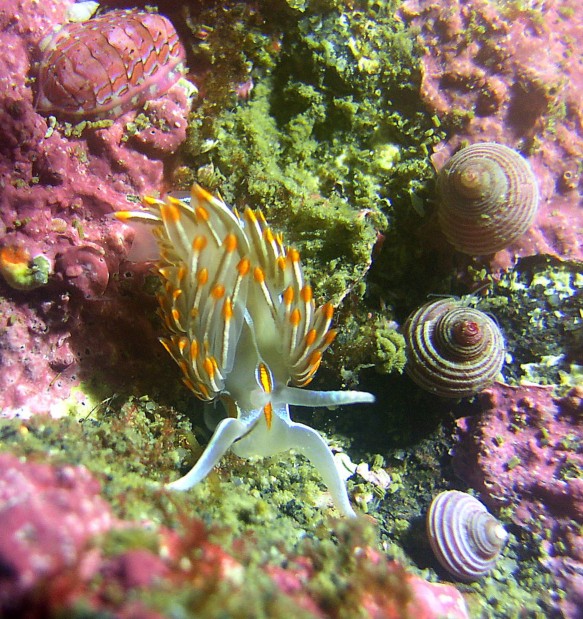Hermissenda crassicornis (Eschscholtz, 1831)Common Name: Northern opalescent nudibranch, Hermissenda |
|
|
Synonyms:
Phidiana crassicornis,
Hermissenda opalescens
|
 |
|
Superfamily Euolidoidea
Tribe Cleioprocta
Family Facelinidae
|
|
|
Hermissendra
crassicornis: Beach 4, WA
|
|
|
(Photo by: Robbie
Wheeling, July, 2002)
|
|
Description: As with other members of suborder Aeolidacea, this species has an anus on the right side, on a conspicuous papilla on the anterior half of the dorsum. The dorsum has numerous outgrowths (cerata) besides the rhinophores, usually arranged in transverse rows. The clavus of the rhinophores cannot be retracted into a sheath (there is no sheath). Hermissenda crassicornis has cerata without a sail-like ridge on the posterior side. None of the cerata are anterior to the rhinophores. The anterolateral margins of the foot are elongated into prominent "pedal tentacles". A mid-dorsal orange band begins just anterior to the rhinophores on the dorsum and passes back at least to the region of the first cerata. This band is usually bordered by a broad, opaque white or luminescent light blue band which begins on the oral tentacles and continues back to the tip of the tail. The distal parts of the cerata are orange, with white at the tip. A white band runs longitudinally from the base to near the tip of the anterior side of each ceras. Body to about 80 mm long, easily recognized when juvenile states due to presence of orange areas on back borderd by bright light-blue lines. Note in the photos below that some have smooth-appearing rhinophores while in others the rhinophores appear annulate.
How to Distinguish from Similar Species:Hermissenda opalescens, the southern opalescent nudibranch, occurs south of Bodega Bay, CA. It is very similar to this species but has no longitudinal white band on the anterior surface of each ceras. Only recently were these two species distinguished by molecular means (Lindsay and Valdes, 2016), so a large number of papers and guides, including Kozloff's key, prior to that date confused the two. Janolus fuscus overall looks similar but its cerata have white tips, the cerata extend to anterior of the rhinophores, and, as an Eolid, its anus is on a papilla in the posterior third of the right side of the dorsum.
Geographical Range:Sitka (Alaska) to Point Reyes, northern California.
Depth Range:Low intertidal zone, subtidal to 35m
Habitat: Common in spring and summer, varied habitats, usually found in rocky pools, marina floats, pilings, and mud flats.
Biology/Natural History: This species eats hydroids, but the diet also includes small sea anemones, bryozoans, colonial ascidians (Aplidium solidum, botryllids), annelids, small crustacea, tiny clams, and dead animals of any sort. Will also eat other Hermissenda individuals. In the Puget Sound, Hermissenda is the main predator of the sea pen Ptilosarcus gurneyi. Mating animals are found year around in the Puget Sound region. The egg string resembles linked pink sausages. They are commonly attached to algae and to blades of eelgrass. Each egg case usually contains one egg, but can contain up to four. Many studies have been carried out on Hermissenda, but the main area of focus is the eye. It has five cells, each about 75 um in diameter, which are large enough to receive a recording electrode. Within the cells it is suspected of containing symbiotic fungi. Hermissenda is an aggressive creature. When two individuals encounter one another fights will break out, which involves lunging and biting. Encounters most likely to induce a fight are those of mutual head contact. The individual whose head is closest to the other's tail or side will usually get the first bite in, and this also means that they usually come out the winner. The copepod Hemicyclops thysanotus is often found adhering to the dorsal surface of Hermissenda.
The nudibranch Phidiana hiltoni
may attack this nudibranch (Goddard et al., 2011)
| Return to: | |||
| Main Page | Alphabetic Index | Systematic Index | Glossary |
References:
Dichotomous Keys:
General References:
McDonald and Nybakken, 1980
Morris et al., (1980)
Scientific Articles:
Goddard, Jeffrey H., Terrence M. Gosliner, and John S. Pearce, 2011. Impacts associated with the recent range shift of the aeolid nudibranch Phidiana hiltoni (Mollusca: Opisthobranchia) in California. Marine Biology DOI:10.1007/s00227-011-1633-7
Lindsay, Tabitha, and Angel Valdes, 2016. The model organism Hermissenda crassicornis (Gastropoda: Heterobranchia) is a species complex. PLoS One 11:4:e0154265. doi: 10.1371/journal.pone.0154265
General Notes and
Observations: Locations,
abundances, unusual behaviors, etc.:

A tiny individual at Cape Flattery, July 2004. Photo by Dave Cowles

This beautiful individual was in a tide pool at Cape
Flattery.
Photo 2006 by Brooke Reiswig

An underwater photo by Kirt Onthank, August 2007
Click Here for a movie of Hermissenda's dorsal heart pumping as the animal crawls around (taken 2014)

Another photo of Hermissenda
crassicornis, by Dave Cowles, July 2018
This
video shows
two very small Hermissenda
crassicornis
that appeared from the seawater system late summer 2019. One individual
is crawling on the bottom of a petri dish while the other one crawls
upside-down
on the surface film of the water. Movie by Dave Cowles, August 2019
Authors and Editors of Page:
Robbie Wheeling (2002): Created original page
Edited by Hans Helmstetler 1-2003, Dave Cowles 2005, 2006-2019